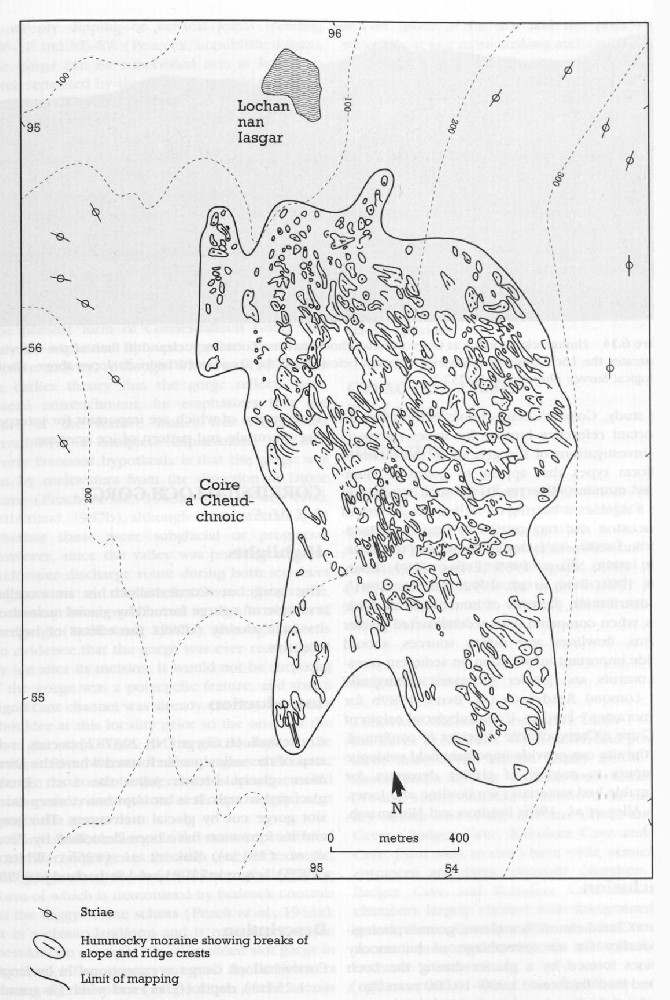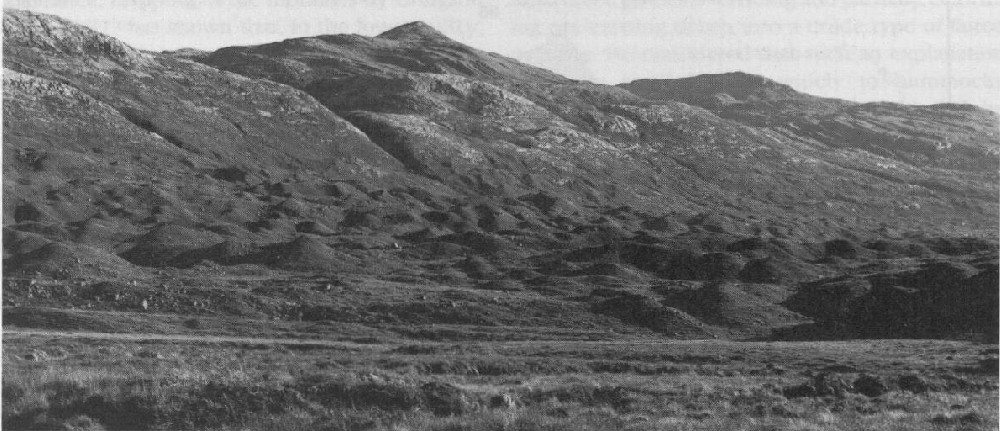Coire a'Cheud-chnoic
J.E. Gordon and D. G. Sutherland
Highlights
This outstanding geomorphological locality is noted for its assemblage of hummocky moraines formed during the Loch Lomond Stadial. These deposits provide important evidence for the processes of glacier activity and wastage.
Introduction
Coire a'Cheud-chnoic (Valley of a Hundred Hills)
Description
Coire a'Cheud-chnoic drains into Glen Torridon from the south-east and is underlain by Torridonian sandstone and north-east aligned belts of Cambrian Quartzite. The greater part of the valley floor is covered by hummocky moraines which reach 8 m in height. Areas of bedrock crop out, implying that there is no great thickness of till under the moraines. Although they have a chaotic appearance, mapping of the moraines by Hodgson (1982, 1987) has shown that, in the lower valley, the majority of the moraines are elongated in a roughly north–south direction (in conformity with striations on the neighbouring bedrock surfaces)
Constituent materials of the hummocky moraine are revealed in a recent roadside quarry at
Interpretation
Hodgson (1982, 1987) concluded that, since the moraines were dominantly composed of exotic material but had been formed by glaciers that were confined to the local valley system, then the moraines were the result of a Loch Lomond Readvance glacier overriding and partially deforming pre-existing debris into a crude type of fluted moraine. He considered that such an explanation could be applied more widely to hummocky moraine in the Highlands of Scotland, although he cited only one particular study, that of Donner and West (1955) on Skye (see the Cuillin), which apparently described similar moraines. Detailed studies elsewhere in Torridon supported his contention that the fluted moraine had formed by subglacial deformation of the sediments (Hodgson, 1982, 1986).
Despite considerable documentation of the location of hummocky moraine and some controversy over its implications for the reconstruction of former ice margins (see the Cairngorms), there have been few detailed studies of its origin until recently. Three main explanations have been proposed (see also Loch Skene and the Cuillin). First, it may be a type of chaotic, 'dead-ice' topography formed by rapid stagnation of ice that carried an extensive cover of supraglacial debris (Sissons, 1967a; Thompson, 1972). Second, it may be produced by controlled or uncontrolled deposition by actively retreating glaciers (Eyles, 1979, 1983; Day, 1983; Horsfield, 1983; Benn, 1990, 1991; Bennett, 1990, 1991; Bennett and Glasser, 1991) (see the Cairngorms). Third, as demonstrated by Hodgson (1982, 1987) for the Coire a'Cheud-chnoic features, it may be a subglacial deposit formed by deformation of preexisting till (see also the Cuillin; Ballantyne, 1989a, Benn, 1991). Probably all three types exist, often in a single area (as in the Cuillin and at Loch Skene), but their relative importance is generally unknown. As the focus of a detailed case study, Coire a'Cheud-chnoic is therefore an important reference locality for wider comparative investigations of the genesis of the different landform types that appear to comprise hummocky moraine. The results of such work may have a significant bearing on interpreting styles of deglaciation and recognition of diagnostic landform and sediment facies assemblages (see Eyles, 1979, 1983; Sharp, 1985; Evans, 1989; Benn, 1990, 1991; Benn et al., 1992; Bennett, 1991). The distribution patterns of hummocky moraine types, when compared with reconstructed glacier margins, flowlines and debris sources, should provide important information on sediment transfer controls and glacier processes during the Loch Lomond Readvance (cf. Benn, 1989b for end moraines). Further, if the subglacial origin of the Coire a'Cheud-chnoic deposits is confirmed, then the site can provide important field evidence for inputs to models of glacier dynamics for deformable bed materials (see Boulton and Jones, 1979; Alley et al., 1986; Boulton and Hindmarsh, 1987).
Conclusion
Coire a'Cheud-chnoic is a classic geomorphological locality for an assemblage of hummocky moraines formed by a glacier during the Loch Lomond Stadial (about 11,000–10,000 years ago). It is one of the best locations in Scotland showing this type of glacial deposit, the form and distribution of which are important for interpreting the mode and pattern of ice wastage.


